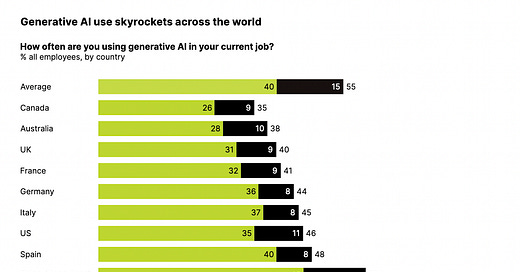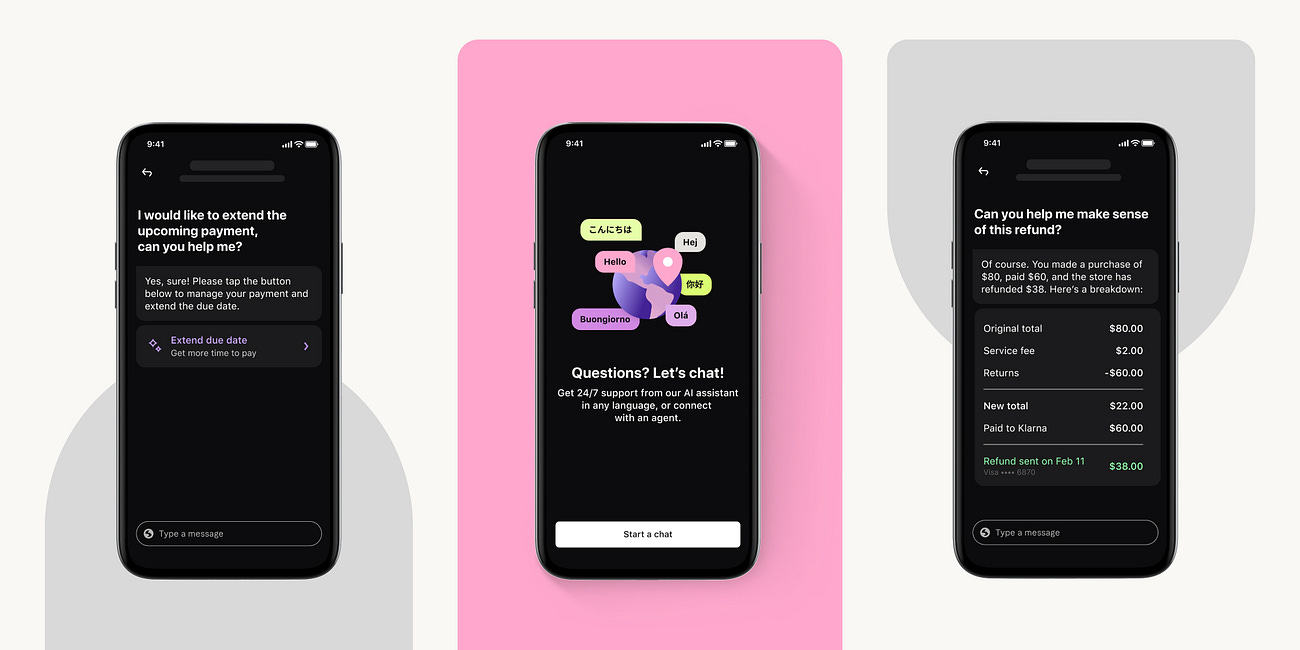Over Half of Business Users Employ Generative AI at Least Weekly
Oliver Wyman Study of 200k People Across 16 countries
A new report from Oliver Wyman reveals several noteworthy statistics. Among more than 200,000 survey respondents across 16 countries in November 2023, an average of 55% use generative AI in their jobs at least once per week, and 15% use it daily. That means 45% are using it less frequently or not at all. The 55% figure reflects a 62% rise in weekly generative AI use between June and November 2023.
The breakdown by country includes a low of 35% in Canada and a high of 83% in India. Mature Western economies cluster near the bottom of the adoption rate list while emerging economic powerhouses such as Brazil, Indonesia, and India are at the top. Despite most of the high-profile generative AI technology emerging from the United States, its workforce fell in the middle in terms of adoption.
The survey of workers included both white-collar and blue-collar positions. Unsurprisingly, white-collar employees are regular users at a rate of about 50% higher than blue-collar users.
Rising Adoption Across Industries
The technology industry has the highest adoption rate, with 75% of white-collar workers using generative AI at least weekly. That figure rose by 29% between June and November 2023. Financial services showed the second-highest weekly generative AI use at 61%, a 69% rise during the year. Among white-collar workers, the public sector and energy showed the fastest growth rates in 2023 at 100% and 83%, respectively.
Hospitality and leisure industries showed the highest generative AI use by blue-collar workers. Fifty-three percent identified as weekly users, a 39% rise between the first and second half of 2023. Retail showed the most significant rise among blue-collar workers at 71%.
The surprising figures were the adoption rate among two blue-collar categories: manufacturing and transportation. Both showed about 50% adoption and 70% and 60% growth rates during the year, respectively. While the broad applicability of large language models (LLM) across use cases is increasingly apparent, it was not obvious that such rapid adoption for these industries and roles was imminent.
Education and Healthcare, which Oliver Wyman categorizes as pink-collar workers, showed the largest rise in use, with respective increases in 2023 of 144% and 264%. Forty-four percent of education industry employees report using generative AI weekly, while 40% have adopted the technology in the healthcare and life sciences industry.
The rise in use among educators may not be surprising. It is widely known that many educators have rushed to use tools that claim to identify whether a written work was authored by AI, in whole or in part. Synthedia research has shown these claims are dubious, but that fact has not restrained many educators from using the technology. Granted, Oliver Wyman did not go deeper into use cases. Educators may also be using the technology for lesson plans, research, and more prosaic activities such as emails.
Generative AI and Healthcare
Healthcare’s rapid adoption rise may be more surprising. Because of the concern about the tendency of generative AI models to “hallucinate,” many people assumed healthcare would be a late adopter of the technology. This position seems to overlook the fundamental problem in healthcare: it is an enterprise that desperately needs higher productivity and many of the barriers to automation are rooted the industry’s reliance on text-based information. Healthcare will not be the fastest adopter across all use cases, but it will be a very large user of generative AI for low-risk applications.
In addition, many of the skeptics of generative AI adoption in healthcare have an overly U.S.-centric view or that of mature Western economies. The study broke down consumer interest in generative AI use in healthcare and compared its support based on the number of doctors across the population by country. Countries with the lowest ratio of doctors to population showed the highest interest in adopting the technology for healthcare needs. Consumers in countries with low ratios, such as India, Indonesia, and Brazil, view generative AI as a tool to expand access to healthcare.
Consumer resistance to using generative AI in healthcare will slow the adoption rate. This will almost surely be true in Australia, Germany, and the UK, particularly if the resistance manifests in hostility. However, there are many ways healthcare providers can adopt generative AI for operational activities that do not involve direct patient interaction.
Granted, there are other reasons for resisting a wholesale embrace of generative AI in healthcare. Legal liability in some countries is a significant concern, as is the potential for AI-based errors that lead to adverse patient events. Adverse events occur frequently in healthcare as a result of human intelligence or carelessness. However, I expect there to be a higher standard for AI due to the general fear of technology and concerns over accountability.
The most significant data that Oliver Wyman’s study exposes is that generative AI is already used widely by healthcare and life sciences professionals and that consumers in many countries welcome its arrival.
Adoption is not Impact
Granted, the absence of use case information is important. If everyone is simply using generative AI to write more concise emails, the impact will be limited. However, the most widely adopted use case is knowledge management assistants. The product manager for Azure OpenAI service told Synthedia that these use cases reflected over 80% of all projects. This is already having profound effect for many organizations, as it can save workers hours each week in simply finding information.
While adoption is not impact, the knowledge management use case is definitely delivering benefits. The challenge, of course, is that many productivity gains don’t immediately translate into realized savings. A more productive workforce can get more done for less cost, but that often requires a company let go employees to capture the full benefits or facilitate growth without additional hiring. The latter situation is only applicable in a growth market, and it may take considerable time before financial impacts are realized.
Klarna is an obvious exception based on its recent announcements. The company says it was able to eliminate 700 contact center employees and will save $40 million in 2024 by using generative AI models from OpenAI. This does not suggest that reducing the workforce is the only benefit that will accrue to companies adopting generative AI. However, the technology carries a cost to implement and operate. Savings will need to come from somewhere to justify the technology spend.
Based on the adoption rates cited by Oliver Wyman, some of the spending appears to be preceding expectations around cost reduction. This will be a trend to watch. On the other hand, many organizations have been under pressure from investors to reduce costs immediately. That has led many companies to cut their workforce expenses now, and many are hoping that generative AI will help drive productivity that will offset the loss of staff capacity.
AI and Jobs
AI will lead to the loss of some jobs. To think otherwise is näive. AI’s impact will be no different than industrial harvesters reducing the need for farmhand labor, the car reducing the need for horses, word processing applications reducing corporate typing pools to zero, industrial robots reducing the number of workers required to operate plants and warehouses, or e-commerce eliminating the need for humans in the order-taking process. The Oliver Wyman study shows that it is likely to have a far-reaching impact across all industries and countries.
In the near term, generative AI will primarily be seen as a productivity enhancement tool for existing employees. Over time, the one-for-one replacement of workers by generative AI such as in the Klarna example will be limited. The more likely scenario is that company departments will not require as many people to maintain the same level of productive output. The result may be a pull-back in hiring before we see widespread job cuts.
An interesting observation by the Oliver Wyman study is the impact generative may have on entry-level positions and what it calls “first-line management.” In the front-line collapse scenario, entry-level employees will no longer be needed as generative AI automates their jobs. A likely problem ensues over time as there are then no entry-level employees available to move up in first-line management when those jobs become available.
Another scenario is what Oliver Wyman calls “Juniorization.” Generative AI acts as a substitute for experience in this scenario, enabling entry-level employees to take on responsibilities that would previously been handled by first-line management. This will create another potential gap in candidate pipelines for middle management. Both of these scenarios are likely to emerge in the next 2-5 years for white-collar workers and companies with largely white-collar staff composition.
Generative AI adoption across businesses is moving faster than expected. While most of the current use cases are unlikely to dramatically shift the workforce composition, over time, this will change as the technology becomes applied to more tasks. Jobs, roles, and functions will shift. The job of a digital marketer didn’t exist thirty years ago. A hundred years ago, there was no role for a database engineer or a factory worker in an AI chip fabrication plant. Some jobs are likely to go away, and new jobs will arise. However, most of the jobs will remain. The workforce will simply have generative AI assistants and tools to help them complete their work.
Klarna Says the Quiet Part Out Loud - Generative AI Can Replace a Lot of Contact Center Staff
Klarna has announced substantial benefits from deploying generative AI for customer support. The AI Assistant is powered by OpenAI large language models (LLM). Klarna said it had handled two-thirds of its customer service chats since and is “capable of managing a range of tasks from multilingual customer service to managing refunds and returns and foste…
Trust is the Hidden Force Shaping the Generative AI Market and Google Keeps Squandering It
On Monday, Google lost $90 billion in market value after news broke that its Gemini generative AI assistant would not create images of white people. Well, it would if you became very clever in your prompt design, but a lot of people noticed that the model was explicitly biased. That was obviously an issue that you would think would arise in testing.











